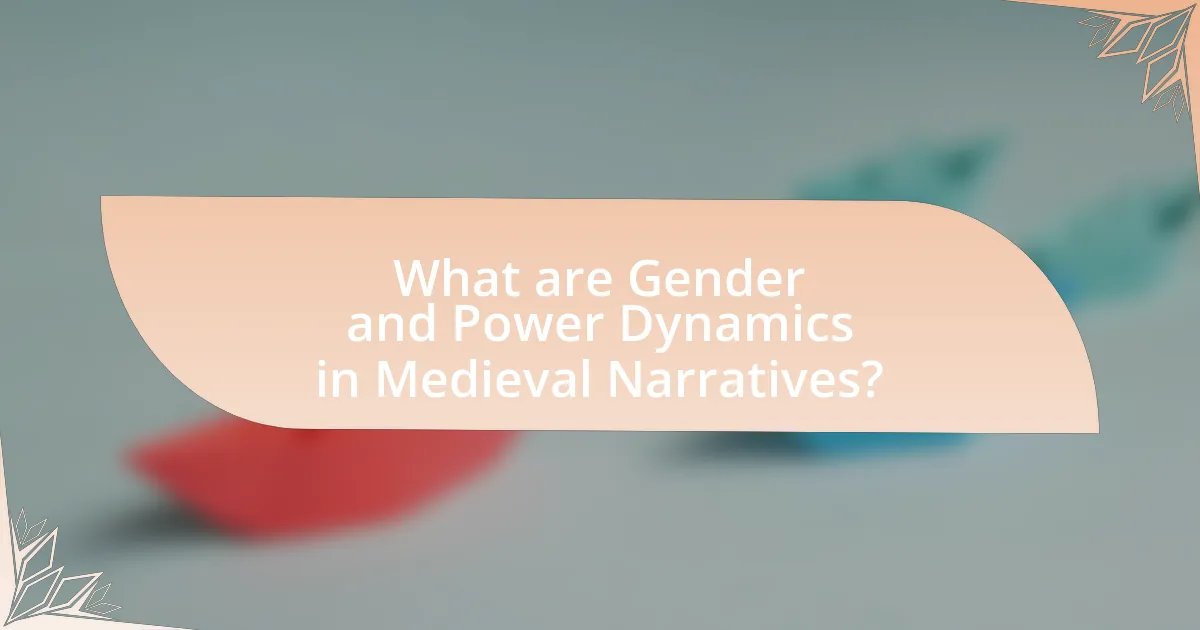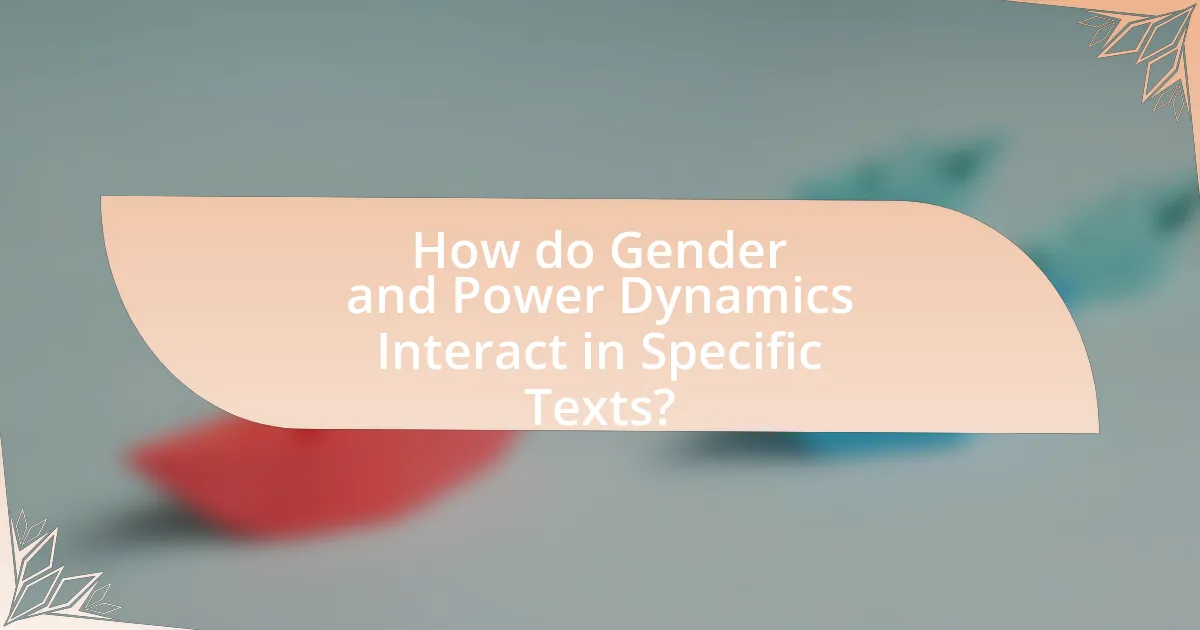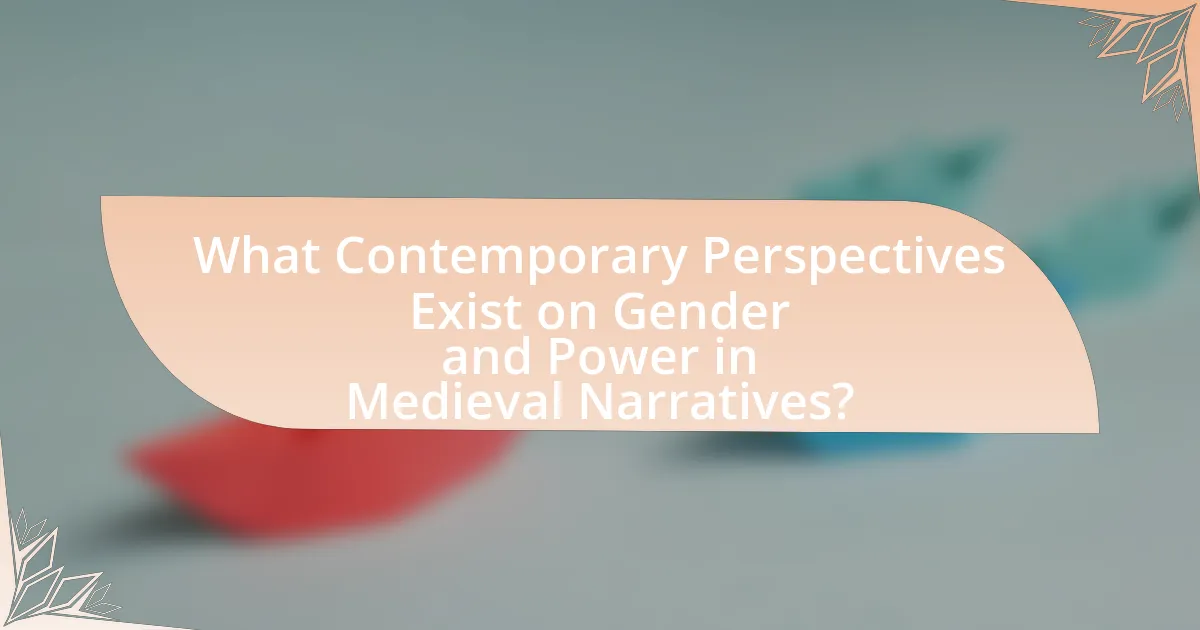The article examines gender and power dynamics in medieval narratives, highlighting how societal norms and hierarchies influenced the portrayal of male and female characters. It discusses the predominance of male authority and the often subordinate roles of women, while also addressing instances where female characters, such as the Wife of Bath in “The Canterbury Tales,” challenge these traditional roles. The analysis includes the impact of historical contexts, stereotypes, and the representation of agency, ultimately revealing the complexities of gender relations and their implications for understanding medieval literature and contemporary discussions on gender equality.

What are Gender and Power Dynamics in Medieval Narratives?
Gender and power dynamics in medieval narratives often reflect the societal norms and hierarchies of the time, illustrating the roles and influences of both men and women. In these narratives, male characters typically hold positions of authority and power, while female characters are often depicted in subordinate roles, constrained by societal expectations. For instance, in works like “The Canterbury Tales” by Geoffrey Chaucer, women such as the Wife of Bath challenge traditional gender roles, yet still operate within a patriarchal framework that limits their autonomy. This duality highlights the complexities of gender relations, where women can exert influence but remain subject to male dominance. Historical context further supports this observation, as medieval society was largely governed by feudal systems that prioritized male lineage and authority, shaping the narratives produced during this period.
How do gender roles manifest in medieval literature?
Gender roles in medieval literature manifest through the portrayal of male and female characters in specific societal roles, often reflecting the patriarchal values of the time. Male characters are frequently depicted as warriors, rulers, or knights, embodying ideals of strength, honor, and authority, while female characters are often relegated to roles of subservience, domesticity, or moral guardianship. For instance, in works like “Sir Gawain and the Green Knight,” male chivalry is celebrated, whereas female figures, such as Morgan le Fay, are often portrayed as manipulative or dangerous, reinforcing the notion of women as either virtuous or threatening. This binary representation underscores the limited agency afforded to women in medieval society, as seen in “The Canterbury Tales,” where women like the Wife of Bath challenge traditional roles but still operate within the constraints of male-dominated narratives. Such depictions illustrate the broader cultural attitudes towards gender during the medieval period, emphasizing the power dynamics that shaped both literature and society.
What are the common stereotypes associated with gender in these narratives?
Common stereotypes associated with gender in medieval narratives include the portrayal of women as passive, submissive figures and men as dominant, heroic warriors. These narratives often depict women primarily in roles related to domesticity, such as caretakers or objects of desire, while men are shown as active agents in conflict and power struggles. Historical texts, such as “The Canterbury Tales” by Geoffrey Chaucer, illustrate these stereotypes through characters like the Wife of Bath, who challenges traditional roles, yet still operates within a framework that emphasizes male authority. Additionally, the chivalric code often glorifies male bravery and honor, reinforcing the notion that men must protect women, thereby limiting female agency.
How do these stereotypes influence character development?
Stereotypes significantly influence character development by shaping the roles and behaviors assigned to characters based on gender norms prevalent in medieval narratives. These narratives often depict male characters as dominant and heroic, while female characters are frequently portrayed as submissive or passive, reinforcing societal expectations of the time. For instance, in works like “Sir Gawain and the Green Knight,” male characters exhibit traits of bravery and honor, while female characters often serve as catalysts for male action, reflecting the limited agency afforded to women. This dynamic not only affects individual character arcs but also perpetuates broader societal stereotypes, limiting the complexity and depth of female characters in these narratives.
Why is the study of power dynamics important in medieval narratives?
The study of power dynamics is important in medieval narratives because it reveals how social hierarchies and gender roles influenced characters and plot development. Analyzing these dynamics allows scholars to understand the complexities of authority, agency, and resistance within the context of medieval society. For instance, works like “Sir Gawain and the Green Knight” illustrate the interplay between chivalric ideals and the subversion of traditional gender roles, highlighting how power is negotiated and contested. This examination provides insight into the cultural values of the time and how they shaped narratives, making the study of power dynamics essential for a comprehensive understanding of medieval literature.
What historical contexts shape these power dynamics?
The historical contexts that shape power dynamics in medieval narratives include feudalism, the Church’s influence, and gender roles. Feudalism established a hierarchical structure where land ownership and loyalty dictated power, often marginalizing women. The Church played a significant role in defining moral and social norms, reinforcing patriarchal values that limited women’s agency. Additionally, societal expectations of gender roles confined women to domestic spheres, impacting their representation and influence in narratives. These contexts collectively illustrate how power dynamics were constructed and maintained in medieval society, as evidenced by texts like “The Canterbury Tales” and “Sir Gawain and the Green Knight,” which reflect these themes.
How do power dynamics affect the plot and themes of medieval stories?
Power dynamics significantly influence the plot and themes of medieval stories by shaping character relationships and societal structures. In these narratives, the struggle for power often drives conflict, as seen in works like “Le Morte d’Arthur,” where the quest for the throne leads to betrayal and war. Additionally, themes of gender roles are prevalent, with female characters frequently depicted as either powerful figures or victims of patriarchal systems, reflecting the historical context of medieval society. For instance, the character of Guinevere embodies both agency and subjugation, illustrating the complexities of female power within a male-dominated framework. Thus, power dynamics not only propel the narrative forward but also serve as a lens through which themes of authority, gender, and morality are explored.

How do Gender and Power Dynamics Interact in Specific Texts?
Gender and power dynamics interact in specific texts by illustrating how societal norms shape the roles and relationships of characters, often reflecting historical contexts. For instance, in medieval narratives like “Sir Gawain and the Green Knight,” the portrayal of women such as Lady Bertilak demonstrates the complexities of power, where femininity is both a source of influence and a tool for manipulation. This text reveals that women wield power through their sexuality and intelligence, challenging the male-dominated structures of the time. Additionally, the character of Gawain embodies the tension between chivalric ideals and personal agency, highlighting how gender expectations dictate behavior and authority. Such interactions are critical for understanding the broader implications of gender roles in medieval literature, as they reveal the underlying power struggles that define human relationships within that historical framework.
What are notable examples of gender and power dynamics in medieval texts?
Notable examples of gender and power dynamics in medieval texts include the portrayal of women in “The Canterbury Tales” by Geoffrey Chaucer and “Le Morte d’Arthur” by Sir Thomas Malory. In “The Canterbury Tales,” the Wife of Bath challenges traditional gender roles by asserting her authority over marriage and sexuality, exemplifying a shift in power dynamics. Similarly, in “Le Morte d’Arthur,” the character of Guinevere navigates her position between loyalty to Arthur and her affair with Lancelot, highlighting the complexities of female agency within a patriarchal society. These texts reflect the tension between societal expectations and individual desires, illustrating the nuanced interplay of gender and power during the medieval period.
How is female agency portrayed in “The Canterbury Tales”?
Female agency in “The Canterbury Tales” is portrayed through the strong, independent characters of women who assert their desires and challenge societal norms. For instance, the Wife of Bath exemplifies this agency by openly discussing her multiple marriages and advocating for female sovereignty in relationships, as seen in her prologue where she argues for women’s right to control their own lives and bodies. Additionally, the character of Prudence in “The Tale of Melibee” demonstrates female wisdom and influence, as she advises her husband on matters of justice and mercy, showcasing the intellectual agency women can possess. These portrayals highlight the complexities of female roles in a patriarchal society, illustrating that women can navigate and manipulate the power dynamics to assert their own identities and desires.
What role does masculinity play in “Beowulf”?
Masculinity plays a central role in “Beowulf,” serving as a defining characteristic of heroism and social status. The protagonist, Beowulf, embodies the ideals of masculinity through his physical strength, bravery, and willingness to confront formidable foes, such as Grendel and the dragon. These traits are celebrated in the narrative, reinforcing the cultural expectation that men should be warriors and protectors. Furthermore, the poem illustrates how masculinity is tied to honor and reputation, as Beowulf’s achievements elevate his status among peers and solidify his legacy. The emphasis on male camaraderie and loyalty among warriors further underscores the importance of masculine bonds in the context of leadership and societal structure in the Anglo-Saxon period.
How do different genres of medieval literature depict gender and power?
Different genres of medieval literature depict gender and power through varying representations of male and female roles, often reflecting societal norms and hierarchies. For instance, chivalric romances frequently portray women as objects of desire or symbols of virtue, while knights embody ideals of masculinity and power, as seen in works like “Sir Gawain and the Green Knight.” In contrast, medieval drama, such as morality plays, often presents women in positions of moral authority or as agents of chaos, challenging traditional power dynamics. Additionally, religious texts, like “The Book of the City of Ladies” by Christine de Pizan, advocate for women’s intellectual and moral capabilities, thereby subverting contemporary gender norms. These literary representations illustrate the complex interplay between gender and power, revealing both reinforcement and critique of societal structures.
What differences exist between chivalric romances and religious texts?
Chivalric romances and religious texts differ primarily in their themes and purposes. Chivalric romances focus on ideals of knightly behavior, courtly love, and adventure, often emphasizing individual heroism and personal honor, as seen in works like “Sir Gawain and the Green Knight.” In contrast, religious texts prioritize spiritual teachings, moral guidance, and communal values, exemplified by the Bible or the Quran, which aim to instruct followers in faith and ethics. The narrative structures also differ; romances typically feature fictionalized plots and characters, while religious texts often convey historical or doctrinal truths. These distinctions highlight the contrasting cultural functions of entertainment versus spiritual edification in medieval literature.
How do folk tales reflect societal views on gender and power?
Folk tales reflect societal views on gender and power by illustrating the roles and expectations assigned to different genders within a cultural context. These narratives often depict male characters as dominant figures who wield authority, while female characters are frequently portrayed in subordinate roles, reinforcing traditional gender hierarchies. For example, in many European folk tales, male heroes embark on quests that symbolize power and agency, while female characters often serve as rewards or obstacles, highlighting their limited autonomy. This pattern is evident in tales like “Cinderella,” where the protagonist’s worth is tied to her beauty and eventual marriage, reflecting societal norms that prioritize women’s roles as wives and mothers. Such representations serve to both mirror and perpetuate the existing power dynamics of the time, making folk tales a valuable lens through which to examine historical attitudes toward gender and authority.

What Contemporary Perspectives Exist on Gender and Power in Medieval Narratives?
Contemporary perspectives on gender and power in medieval narratives emphasize the complexities of gender roles and the subversion of traditional power dynamics. Scholars argue that medieval texts often reflect patriarchal structures while simultaneously offering spaces for female agency and resistance. For instance, works like “The Canterbury Tales” by Geoffrey Chaucer and “Sir Gawain and the Green Knight” reveal nuanced portrayals of women who navigate and sometimes challenge societal expectations. Research by scholars such as Ruth Mazo Karras highlights how these narratives can be reinterpreted to understand the fluidity of gender and power, suggesting that medieval literature provides insights into the historical construction of gender identities.
How do modern scholars interpret gender roles in medieval literature?
Modern scholars interpret gender roles in medieval literature as complex and often reflective of societal norms that both reinforce and challenge traditional gender binaries. Scholars analyze texts such as “The Canterbury Tales” and “Sir Gawain and the Green Knight” to illustrate how female characters often wield power through subversion or manipulation of male authority, indicating a nuanced understanding of gender dynamics. For instance, the character of the Wife of Bath in “The Canterbury Tales” is seen as a figure who challenges patriarchal norms by asserting her sexual agency and independence, which has led to discussions about the intersection of gender and power in medieval society. This interpretation is supported by feminist literary criticism, which emphasizes the importance of context in understanding how gender roles are portrayed and the implications these portrayals have on contemporary views of gender.
What methodologies are used to analyze these narratives today?
Qualitative methodologies, including narrative analysis, discourse analysis, and feminist literary criticism, are used to analyze gender and power dynamics in medieval narratives today. Narrative analysis focuses on the structure and function of stories, revealing how gender roles are constructed and represented. Discourse analysis examines language and power relations within texts, highlighting how narratives shape societal norms regarding gender. Feminist literary criticism critiques the portrayal of women and power in literature, emphasizing the historical context and its implications for understanding gender dynamics. These methodologies provide a comprehensive framework for exploring the complexities of gender and power in medieval narratives.
How has feminist literary criticism influenced the understanding of these texts?
Feminist literary criticism has significantly influenced the understanding of medieval texts by highlighting the representation of gender roles and power dynamics within these narratives. This critical approach reveals how women are often portrayed in subordinate positions, reflecting societal norms of the time, and challenges traditional interpretations that overlook female agency. For instance, scholars like Elaine Showalter and Sandra Gilbert have analyzed works such as “The Canterbury Tales” and “Sir Gawain and the Green Knight,” demonstrating how these texts can be reinterpreted to reveal underlying feminist themes and critiques of patriarchal structures. By applying feminist theory, critics have uncovered the complexities of female characters and their relationships, thereby enriching the discourse surrounding gender and power in medieval literature.
What lessons can be drawn from medieval narratives regarding gender and power?
Medieval narratives reveal that gender roles were deeply intertwined with power structures, often depicting women as both powerful figures and victims of patriarchal systems. For instance, characters like Eleanor of Aquitaine illustrate how women could wield significant political influence, yet narratives frequently reinforced their subjugation through themes of marriage and inheritance. Additionally, texts such as “The Canterbury Tales” by Geoffrey Chaucer showcase female characters who challenge societal norms, indicating that narratives served as a reflection of both the constraints and the potential for female agency within a male-dominated society. These examples demonstrate that medieval literature not only mirrored the gender dynamics of its time but also provided commentary on the complexities of power relations between genders.
How can these narratives inform current discussions on gender equality?
Medieval narratives can inform current discussions on gender equality by illustrating historical power dynamics and gender roles that persist today. These narratives often depict women in positions of subjugation or as passive figures, reflecting societal norms that marginalized female voices. For instance, the portrayal of women in works like “The Canterbury Tales” by Geoffrey Chaucer highlights the limited agency afforded to women, which can be compared to contemporary issues of gender inequality in various cultures. By analyzing these historical representations, current discussions can better understand the roots of gender disparities and the importance of challenging traditional narratives to promote equality.
What practical insights can be gained from analyzing gender dynamics in medieval literature?
Analyzing gender dynamics in medieval literature reveals insights into societal norms, power structures, and the roles assigned to different genders during that period. For instance, texts such as “The Canterbury Tales” by Geoffrey Chaucer illustrate the varying degrees of agency and authority afforded to male and female characters, reflecting the patriarchal values of medieval society. Additionally, the examination of works like “Sir Gawain and the Green Knight” highlights how masculinity is constructed through chivalric ideals, while female characters often embody moral and ethical challenges to male protagonists. These literary analyses provide a deeper understanding of how gender influenced social hierarchies and individual identities in medieval contexts, thereby informing contemporary discussions on gender roles and power dynamics.